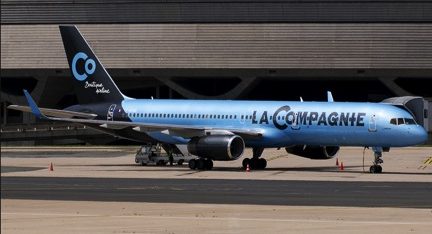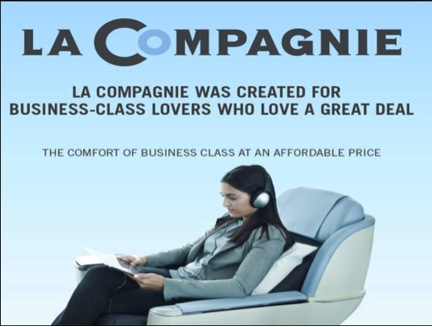The Brave New World of Disruptor Airlines for Business Travelers
By Peter Greenberg
There’s a lot to be said about incumbency, especially when it is successful, entrenched and has little competition. After years of merger, consolidation and a fair amount of failure, the big four U.S. airlines now have their strongest balance sheets in history. But history also has shown that incumbents rarely react to disruptive services and products until it’s too late. In the airline business, there are understandable reasons for it — either the market is perceived as too small, or there’s the risk — especially in terms of fares — of cannibalizing their own business.
But even at a time of great profit and pricing control, there are those who see opportunity, especially with business travelers.
Enter the era of the disrupter business airlines.
But the newest business airlines don’t even call themselves traditional airlines, and at least one doesn’t call itself an airline at all. But for a growing number of corporations and individual business travelers flying on these routes, these airlines are slowly becoming financially viable alternatives.
There has been a noticeable, small but growing shift in business travel choices, based primarily on budget. Schedule is still important, as well as frequency. But the traditional business travel approach to airlines seems to be changing, with or without frequency. “It’s not about whether an airline has a corporate business travel plan anymore,” says one corporate travel manager. “It’s about a bigger picture of total fiscal compliance and common sense.”
Of course, business travel policy remains a game of numbers. But the major U.S. airlines are no longer competing for market share, but yield, and some markets are either being ignored or they’re being priced out, or both.”
If necessity is indeed the mother of invention, then it’s almost inevitable that the status quo may be challenged.
Here come the disrupters.
Norwegian
One airline analyst describes the situation as nothing short of an “international food fight.” And at the center of it an upstart airline called Norwegian.
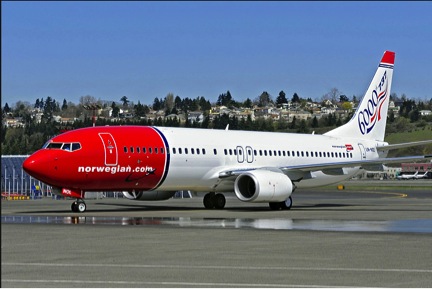
Low Cost Norwegian Air wants more business class passengers
If the potential for disruption can be predicted by the amount of opposition a business model stirs, then just about everyone in the airline world is keeping an eye on Norwegian Air, once a domestic carrier turned into a highly competitive long haul LCC. (It has quietly become the third largest low cost carrier in Europe)
It gets down to this: an airline operating under Irish laws but based in Norway and also hubbing in Thailand, flying a Singaporean crew under European Union open skies protections — and they are somehow beating the major airlines at their own game, playing by the existing rules.
Norwegian Air’s request for a permanent foreign carrier permit has the backing of the EU executive commission, but is being fought by the Big 3 U.S. carriers, Delta Airlines Inc., American Airlines Group, United Continental Holding, and airline and labor unions, who claim it will undermine U.S. wages. Under the 2007 open-skies agreement, EU airlines can fly to the United States from anywhere in the 28-country bloc, and vice versa.
“I don’t know much about American politics,” says CEO Bjorn Kos, a former fighter pilot and attorney, “but there is no reason to reject our application.”
Norwegian’s initial business model was only tourists. But Kos has priced his flights so low that 15 per cent of his passengers are now business travelers and that number is growing.
Each of his eight Boeing Dreamliners has 32 “premium tourist” class seats, with more room, lounge access, fast track immigration departure and arrival and checked bags included in the fare. Another nine Dreamliners are on order for delivery by 2018.
And with current load factors in the high 80’s, Kos is wasting no time trying to fill those planes. He’s already heading South looking for routes in both South America and South Africa.
La Compagnie
Fritz Yvelin and Peter Luethi first came to know each other when they joined forces to create an all business class airline called L’Avion (which was later sold to British Airways in 2008 and became Open Skies).
And even though airlines like L’Avion and Max Jet and Silver Jet failed — using essentially the same all business class model, the pair hasn’t given up and claims the global economy numbers indicate the time is now right for their business jet travel concept. “We decided it was time for a niche operation again,” said Luethi, and the pair raised $30 million from 40 European investors in 2013.
Passenger comfort was again on their minds when they launched La Compagnie as an all business airline in 2014. But so was pain.
“There are two kinds of pain as a passenger: One is physical when you pay little and have no comfort; the other is monetary where you fly business class and you pay a lot,” Luethi says.
Consolidation in the industry had reduced the premium area capacity and prices had increased. From their perspective, the “pain” of flying coach had only gotten worse and the pain of paying for comfort in business class had gotten even more expensive.
So La Compagnie took off last summer with one 757 — inherited from Icelandair — and then reconfigured for just 74 passengers – about half the usual number — in lie-flat seats — from Charles de Gaulle to Newark. Currently the airline flies six days a week. A second 757 was delivered in early December for a new London to Newark route.
The lowest round-trip La Compagnie ticket available on the website is about $1,600, no advance purchase necessary, 30 to 50 percent less than legacy carriers, and a few hundred dollars more than coach on these same carriers. And when La Compagnie inaugurated the London route, it cut $1800 off the cost of its business class flights, essentially offering front of the cabin service at RyanAir prices. (Norwegian has been offering one way coach tickets from Gatwick to New York’s JFK for about $240, well below its competitors.)
For most airlines to survive, they need to grow, but Luethi sees La Compagnie’s expansion coming not in more routes, but in doubling up its current routes, offering morning as well as evening flights.
Load factors for the new airline are averaging around 60 per cent. Not great, but not disastrous. But what keeps La Compagnie in the air is that return passengers are averaging around 28 per cent. “We don’t want to be seen as the disrupter,” Luethi insists. “Instead we want to provide comfort and price relief. In the long run, that’s what matters.”
In the meantime, there are even more surprises with airlines that — if not entirely changing their business model — are now suddenly appealing to business travelers.
Airlines like Southwest and, in Europe, Ryan Air are formulating a corporate business travel model. And other airlines, like Spirit and Allegiant, are — and this is especially surprising — adding capacity in a number of markets to appeal to business travelers.
“It’s become a little funny,” says one major airline executive. “A growing number of budget conscious business travelers are almost flying in denial on airlines like Spirit and Allegiant. They’re like the Claude Rains character in Casablanca, shocked to discover there’s gambling at rick’s casino and then collecting their winnings from the night before.”
Three U.S. airlines are bucking the industry trend of capacity discipline and are aggressively adding seats, routes and planes, and reaching out to business travelers.
In 2014, Spirit grew its ASMs (available seat miles) a staggering 19% and plans to grow a whopping 30% this year. And that’s with a route network that includes 29 U.S. cities, 12 destinations in the Caribbean and 10 in Latin America. And Spirit has announced 37 new nonstop routes, ranging from Baltimore to Los Angeles, Los Angeles to Kansas City, and nine new cities from Atlanta and 10 new destinations from Houston. Frontier expanded its ASM’s by 14% and Allegiant, which now flies its fleet of 71 planes to 99 cities in 40 states, grew their ASM’s by nearly 9% last year. “Most business travelers would have never considered Spirit, Allegiant or Frontier a few years ago,” says the Wall Street Journal’s Scott McCartney, who tracks business travel. “And while they officially claim they’d never fly them, the numbers speak a different story. That’s a huge shift in business models, for both the airlines themselves and the business travelers now — quietly — flying them.”
And then, there’s a business airline that’s not really an airline…It’s a membership club
Surf Air
Surf Air has been called everything from the “Netflix of airlines” to the airline for “the bottom half of the one percent,” says Mark Alioto, who runs a software and consulting business in California. He signed up when the airline began flying between the San Francisco area and Los Angeles. For Alioto, Surf Air is also not a traditional business travel experience. Instead, he calls it an affordable convenience and a networking opportunity.
“Because a lot of members are ‘early adopters’ you get a super interesting group of people, tech, writers, actors. It’s like a TED Talk in the sky,’” says Alioto, 52, who lives in Los Angeles and flies Surf Air to the San Carlos Airport between San Francisco and Silicon Valley.
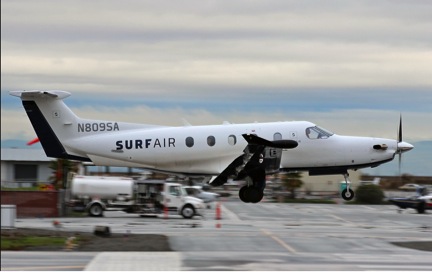
Surf Air believes intrastate business travelers don’t need corporate jets
He flies three out of four weeks a month for business and to visit family in San Francisco. By being a “founding member,” Alioto paid a $500 initiation fee and now pays $1000 a month for as many flights as he can book on the airline’s 8-seat, single-engine Turbo-prop Pilatus PC-12, with BMW-designed executive interior.
Unlike fractional jet ownership, Alioto likes the fact there is a schedule – instead of a time range. But like flying a private, he doesn’t have to go through security and there is free parking at airports used by Surf. “When I did the math – the cost of driving, flying commercial and wait time – there was no better, effective use of my time which is valuable. I just show up 15 minutes before,” he says.
New members don’t get quite as good a deal. “They’ve toned down the ‘all-you-can-eat-buffet’ aspect,” says airline consultant Bob Mann, who was an American Airlines executive when it launched its legendary Air Pass program in the ‘80s. A new Surf member now pays $1,000 initiation fee and $1,750 a month. Instead of booking unlimited flights, a new member gets 2 passes and as soon as they have landed from one flight, they can book another and keep rebooking. Two memberships cost $1500 a month each. Each passenger books one seat per flight leg, sharing the aircraft with other members vs. traditional charter programs where the entire aircraft is reserved.
Surf Air now claims 1,300 members and some 400 individuals on
the membership waiting list. And they are already expanding their route network, with more than 30 daily departures between Burbank, Oakland, Hawthorne, San Carlos, Santa Barbara, Truckee Tahoe, and Las Vegas.
There’s no frequent flier program, and no WIFI on board. But there are frequent fliers. Average Surf air passenger flies 3.8 segments a month, or roughly two round trips. And no one complains about the inability to earn miles. “Our passengers save so much time getting on and off our flights it more than makes up for it in terms of value,” Potter insists. “You drive right up to the terminal and park about 40 feet away. The parking is free. No TSA checkpoint. You walk into the terminal, show your ID and walk on the plane.” Total distance: about 300 feet.
Surf Air hardly has the skies to itself. Commercial airlines have always had frequency and connectivity. And for the past 15 years, for those business travelers willing and able to pay higher prices, there have been fractional programs and charter operations
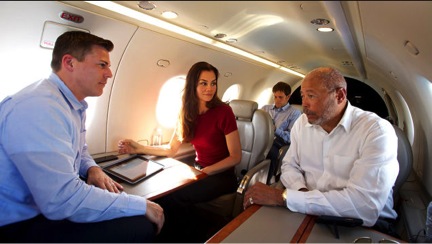
Surf Air’s face-to-face seats are the most popular
that offer privacy and that leave on demand.
But Surf Air is counting on its fare base, use of small airports, private terminals, and concierge check-in — not to mention passengers’ ability to keep their shoes on and free parking, to keep them flying.
Analyst Mann agrees the Surf business traveler model could be exportable to other locations, particularly to Florida and Texas. “Business airlines don’t have to be jets. Airplanes can have propellers.”
Air Choice One
That’s certainly the case with Air Choice One, a business carrier run as a family business out of St. Louis, already an underserved airport.
The CEO is Shane Storz. His sister is the CFO. Storz watched his parents start a “Mom and Pop” airline, offering crop dusting and helicopter rides. Air Choice One has 120 employees and is trying to fly into the future with an updated “old school” business model.
Simply put, Air Choice One is serving the cities the big boys pulled out of. “We’re catering to the Mason City, Iowas, the Decaturs, the Burlingtons,” he says. “They really appreciate the hands on service. We pretty much live in the community we are flying to. We go in and join the Chamber, the Rotary, and the Lions Club. We do presentations to larger companies about how we perform, Storz says. “And that’s how we get the corporate business as well.
Currently, he says, his passenger load is 60 percent leisure, 40 percent business traveler. But the business numbers are growing “What we’re finding in these rural communities,” he says, “is that when service declined then business travelers from Mason City got back on the highway to Minneapolis. We’re trying to capture them back.”
Storz acknowledges the role small community grants and Department of Transportations Essential Air Service (EAS) subsidies played in Air Choice moving into scheduled service in 2008 from an aircraft rental, maintenance, management and charter service business.
The airline operates seven Cessna Grand Caravan’s with leather seats and extra leg room in eight passenger configurations from its hubs in St. Louis and Chicago, flying to five small cities in Illinois, Iowa and, Michigan. Flights between Mason City, Ia., population about 28,000, and Chicago O’Hare were added in November. Flights to Fort Dodge, Ia., are scheduled to begin in February. As an example of the federal subsidy, a one-way ticket for the hour and a half flight from St. Louis to Jonesboro, Ark, a business passenger pays from $35 to $60 with an EAS subsidy of $189 to $198.
But can Air Choice One survive without the subsidy? The only way, Storz says, is by growth. Adding routes and plane size. “With the subsidy we can keep fares low and demonstrate our reliability and dependability from the community’s perspective,” he says. “Through word of mouth and great experiences, we’ll get people back at least for a one-time trial. Our goal is to jump start the program and get our ridership up to larger 70-seater planes. Storz has his eye on the Bombardier Q400-8 and more routes, including service to traditionally underserved Eastern Pennsylvania cities.
CBS Travel Editor Peter Greenberg is a frequent contributor to the East-West News Service


